6.301 Solid-State Circuits
advertisement
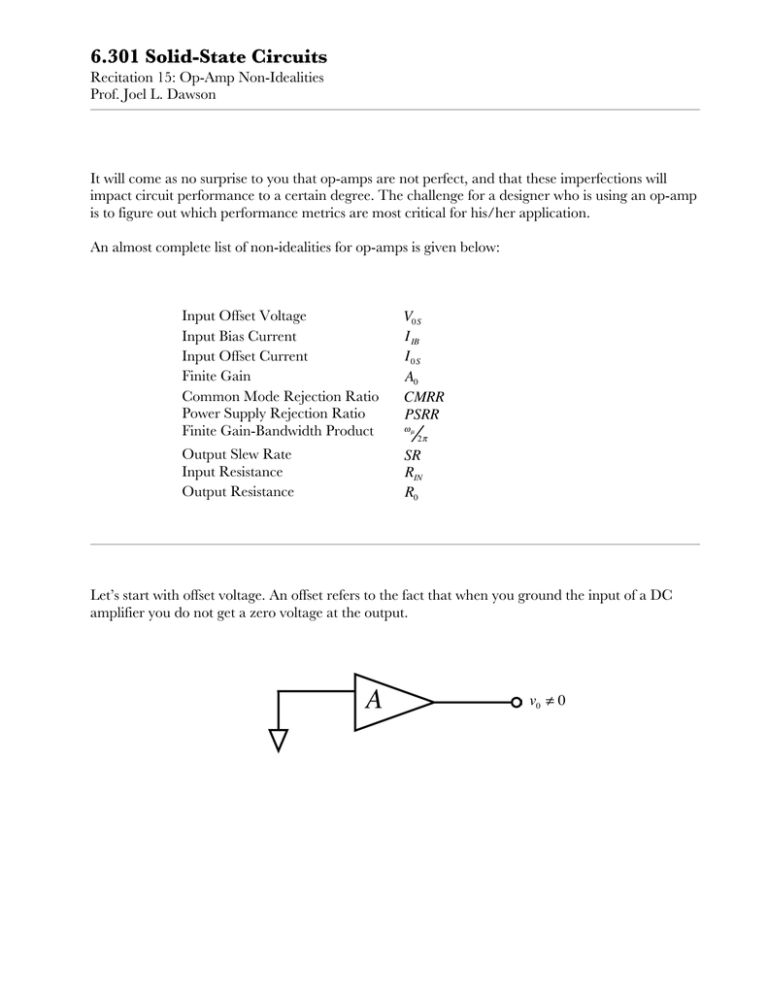
6.301 Solid-State Circuits Recitation 15: Op-Amp Non-Idealities Prof. Joel L. Dawson It will come as no surprise to you that op-amps are not perfect, and that these imperfections will impact circuit performance to a certain degree. The challenge for a designer who is using an op-amp is to figure out which performance metrics are most critical for his/her application. An almost complete list of non-idealities for op-amps is given below: Input Offset Voltage Input Bias Current Input Offset Current Finite Gain Common Mode Rejection Ratio Power Supply Rejection Ratio Finite Gain-Bandwidth Product V0S I IB I 0S A0 CMRR PSRR Output Slew Rate Input Resistance Output Resistance SR RIN R0 ωµ 2π Let’s start with offset voltage. An offset refers to the fact that when you ground the input of a DC amplifier you do not get a zero voltage at the output. A v0 ≠ 0 6.301 Solid-State Circuits Recitation 14: Op-Amp Non-Idealities Prof. Joel L. Dawson We model this in ways that you might expect. If, when we ground the input of this DC amp, we measure AV output voltage of V0S , we can adjust our diagram according to: + A + Σ V0S In this case, we speak of V0S as the “offset referred to the output.” That is to differentiate it from the “offset referred to the input,” as follows: + + Σ A V0S A Many times, it will be more convenient analytically to choose one form over the other. For instance, suppose we were interested in the effect of an offset on our familiar inverting op-amp amplifier. R2 R1 − vI v0 + + V0S − Page 2 6.301 Solid-State Circuits Recitation 14: Op-Amp Non-Idealities Prof. Joel L. Dawson Using the approximation that vt v , we have vI − V0S V0S − v0 = R1 R2 R2 ( vI − V0S ) − V0S = −v0 R1 ⎛ R ⎞ R v0 = V0S ⎜ 1 + 2 ⎟ − vI 2 R1 ⎠ R1 ⎝ So the more gain we ask for, the more offset we can expect at the output. Note that this is a more serious impairment for op-amp integrators. 1 CS R1 − vI + + V0S − Substituting in the expression we just derived: ⎛ 1 ⎞ 1 v0 = V0S ⎜ 1 + − vI ⎟ R1CS ⎠ R1CS ⎝ v0 (t) = V0S + 1 1 V0S dt − vI (t)dt ∫ R1C R1C ∫ Page 3 v0 6.301 Solid-State Circuits Recitation 14: Op-Amp Non-Idealities Prof. Joel L. Dawson This is one reason why you never see op-amp integrators used in a stand-alone, open-loop way: They just integrate their own offset until they hit a supply rail. In the context of a control loop, we’d be okay: ⇒ 1 R1CS + Σ + 1 R1CS V0S 1 X(S) − + Σ + 1 R1CS Σ V0S S Apply superposition: (1) Y (S) = 1 X(S) R1CS + 1 (2) Y (S) = 1 V0S R1CS + 1 S Final value theorem (3) Y (S) = y(t) Treating the offset like a step. t=x = V0S t =∞ =0 R1CS V0S R1CS + 1 S Final value theorem y(t) Page 4 Σ V0S + Σ V0S 3 S 2 + Y (S) 6.301 Solid-State Circuits Recitation 14: Op-Amp Non-Idealities Prof. Joel L. Dawson CLASS EXERCISE: Where does this offset come from? Consider the simple op-amp from the last recitation: IN 2 IN1 −A v0 Q2 Q1 (1) Remind yourselves of which input is the inverting terminal, and which input is the noninverting terminal. (2) Notice that there will be an imbalance created by the base currents of Q1 and Q2 . How should we apply a differential voltage on IN1 and IN 2 to correct this? Page 5 6.301 Solid-State Circuits Recitation 14: Op-Amp Non-Idealities Prof. Joel L. Dawson So how would you measure the input referred offset of a real op-amp? Pretty easy + + V0S + v0 − − − 999R R 999R ⎞ ⎛ v0 = ⎜ 1 + ⎟ V0S = 1000V0S ⎝ R ⎠ Only caveat: Remember that bipolar op-amps have input bias currents too. They can be modeled: + + V0S ↓ I IB + − 999R − ↓ I IB R If you’re measuring offset, make sure that I IB R V0S . Page 6 v0 − MIT OpenCourseWare http://ocw.mit.edu 6.301 Solid-State Circuits Fall 2010 For information about citing these materials or our Terms of Use, visit: http://ocw.mit.edu/terms.
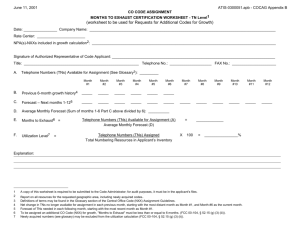



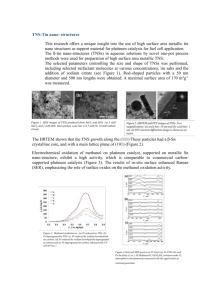
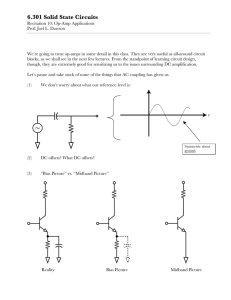
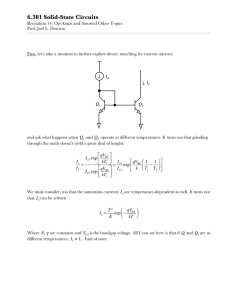
![(TNS Foundation)[1]](http://s3.studylib.net/store/data/007346973_1-c15d24f994805b770e00d79c8993f9db-300x300.png)